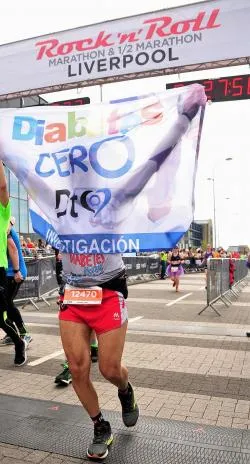When diabetes is diagnosed with a child, the life of the whole family changes.Fears and uncertainties invade parents because they do not know how the disease will affect the child's day to day, if it will have an impact on their future and, above all, if you can continue to lead a normal life.
«The impact is very important for parents.Suddenly, they receive the diagnosis of a chronic disease that can be controlled, but that will require teaching and learning to be able to integrate the child with good care of diabetes in their daily environment, ”explains Dr. Raquel Barrio, coordinator of thePediatric Diabetology Unit of the Ramón y Cajal University Hospital in Madrid.
Precisely, this unit is not only taking care of more than 10,000 patients-approximately 400 a year-since its launch in 1977 and a long experience but also has been accredited as a unit of excellence by DNV GL-Business Assurance being beingAt present, the first center of Spain to receive accreditation for its educational program for patients who initiate insulin pump therapy.
The recognition accredits and endorses the educational project of the unit, through which processes, times and materials have been systematized with continuous support to patients in regards to their periodic controls and the correct management of their insulin pump.The unit serves as a model for other centers in the formation and treatment of patients with this disease with the aim of improving the efficiency of diabetes units in Spain.
Autoimmune disease
Type 1a diabetes mellitus (DM1A), also known as youth or insulin -dependent diabetes, is an autoimmune disease that is characterized by absolute insulin deficiency.The reason is the destruction of the beta cells of the pancreas, responsible for synthesizing and segregating this hormone whose function is to control blood glucose levels.Unlike type 2 diabetes, which usually appears in adulthood and is associated with lifestyle, type 1 is the most frequent in childhood and its risk factors are not entirely known.In this way, while type 2 can be prevented, it is not in the case of youth diabetes.
Dr. Amparo Rodríguez Sánchez, head of the Pediatric Endocrinology Service of the HM Montepríncipe University Hospital, advises “not wasting time and devoting himself to the knowledge and management of this disease because parents, along with their children, are a basic and essential pillarof treatment ».For all this, it is very important that both the child and his parents reach the maximum knowledge of the disease.
Our role is to provide the tools to need, both the child and their parents, from the moment of diagnosis. They work with them so that, first, know what diabetes is, we explain it in a closer waythat when the doctor gives the diagnosis.Then we approach the treatment and how it will influence your life.
We teach them at what levels it has to be within normality, how we will value them (glycemic controls on the finger with a glucometer and a reactive strip or continuous glucose monitoring), interpret them and know how to make a decision, that is, eat ifI am below normal or put insulin well to eat or to correct that excess of blood glucose called hyperglycemia.Also how to quantify within a normal meal of what is formed and how carbohydrates have an impact on glycemia ».
Unlike what can be thought, it is not necessary to follow a re -destructive diet but «to fulfill the criteria of the WHO of Mediterranean diet.Carbohydrates are fundamental in the development of a child and must mean 50-60 percent of the menu,15 percent protein and the rest, fat, preferably polyunsaturated such as olive oil or nuts and avoid saturated.
In short, it is a diet model suitable for the whole family, ”says Yelmo.Of course, there are small tips that can help them make the diet even healthier.«We recommend that they drink low glycemic carbohydrates such as integral rice or legumeBaked in front of fried and rebobed, ”he adds.
by ages
The child's age will also mark the way of facing the disease.«At 6-7 years it is the age in which they accept it well because, suddenly, they are heroes.They are punctured and everything they receive is positive, such as other children are amazed when they have to click and do not care.But it is true that we start working with them according to maturity, but around the eight-diez is the age in which we try to be independent and punctuate themselves.To do this, we make group workshops, 3-4 children of the same condition and put an older to make it your tutor.
Imitation mode works very well and loses fear.With the teenager we are faced with a very important stage and in which we have to be very aware and we talk to you as adults and leave them alone.We try to make food registration, physical exercise, etc.There are also those who call total abhorrents, who are very difficult to treat and do not want contact with us, but you have to go little by little and even there are cases that need the visit to the psychologist.Finally, before this child goes to the adult unit, although he has already integrated the disease in his life, there are new concepts that must be reinforced, ”explains the diabetological educator.
This same opinion is shared by Barrio, who adds that «the child is getting independently independent according to the degree of maturity, but they learn very soon to make themselves the controls on the finger, namely the carbohydrates of the food... In the teaching process there are continuous recycling: to the debut, a week, a month and every time they come, every two or three months, in addition to the workshops, courses, etc.
It has to be continuous learning because, although it is complex, they end up knowing a lot and you have to give them time ».In the case of schools, the expert continues, "if they have a nurse, everything is much easier, but if not a teachers who voluntarily want to collaborate, although they are usually very active, they have to receive specific training."
in the first person
Belén is a six -year -old boy, José María, whom at two and a half years he was diagnosed with type 1 diabetes. «We realized that he was losing weight despite being eating constantly and he was a long time.We went to the hospital, made some blood tests that revealed high glucose levels and began to treat him, ”he says.Despite the hereditary character of the disease, José María had no family history.
As for treatment, "they started with insulin injections for six, but for four years they put an insulin bomb that has made life much easier because you can reprogram and give you flexibility that the injections do not have,"Belén account.In the Pediatric Endocrinology and Diabetes Unit of the Ramón y Cajal Hospital, where they treat José María, «they offer you information, training and resources about the disease you are handling that it is very serious.It takes away many fears and taboos because the lack of information is the worst that can happen to parents.
You can contact 24 hours a day and if you doubt you reassures you.When I get to adolescence, hormones may rise and may need a new training and, even in two years it will have to be autonomous, but it is in very good hands, ”he concludes.Another case is that of José, a 16 -year -old patient who was diagnosed with the disease with four years.«At 4 years I started with symptoms: I was tired all the time and lost weight.
They made me analysis and the diagnosis appeared.Until the age of eight they treated me in Segovia, but when I moved to Madrid to the Ramón y Cajal hospital they put the insulin bomb, ”he says.Although his grandmother and an uncle of his were diabetic, "my parents were new in this and until they did not put the insulin bomb, I had a bad click so many times."
Now, and despite the adolescence stage, which entails more exits, meals and studies, «I have no problem and I adapt very well and I am always trying to eat healthy.In addition, the bomb has changed my life and is an absolute improvement in all aspects.I have gone from having to click up to five times a day not to do it or once every three days, ”he concludes.



